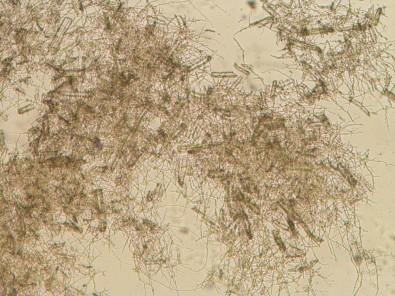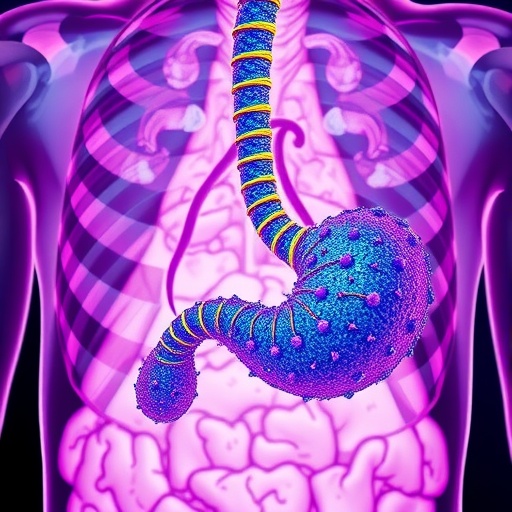Brazilian researchers used genetic engineering to develop a low-cost platform for the production of enzymes that break down sugarcane trash and bagasse for conversion into biofuel. The novel molecules have many potential industrial applications.

Credit: LNBR-CNPEM
By Maria Fernanda Ziegler | Agência FAPESP – Researchers at the Brazilian Center for Research in Energy and Materials (CNPEM) have genetically engineered a fungus to produce a cocktail of enzymes that break down the carbohydrates in biomass, such as sugarcane trash (tops and leaves) and bagasse, into fermentable sugar for industrially efficient conversion into biofuel.
The development of low-cost enzyme cocktails is one of the main challenges in producing second-generation ethanol.
Second-generation biofuels are manufactured from various kinds of nonfood biomass, including agricultural residues, wood chips and waste cooking oil. The CNPEM research group’s process paves the way for optimized use of sugarcane residues to produce biofuels.
The fungus Trichoderma reesei is one of the most prolific producers of plant cell wall-degrading enzymes and is widely used in the biotechnology industry. To enhance its productivity as a biofactory for the enzyme cocktail in question, the researchers introduced six genetic modifications into RUT-C30, a publicly available strain of the fungus. They patented the process and reported it in an article published in the journal Biotechnology for Biofuels.
“The fungus was rationally modified to maximize production of these enzymes of biotechnological interest. Using the CRISPR/Cas9 gene-editing technique, we modified transcription factors to regulate the expression of genes associated with the enzymes, deleted proteases that caused problems with the stability of the enzyme cocktail, and added important enzymes the fungus lacks in nature. As a result, we were able to allow the fungus produce a large amount of enzymes from agroindustrial waste, a cheap and abundant feedstock in Brazil,” Mario T. Murakami, Scientific Director of CNPEM’s Biorenewables Laboratory (LNBR), told Agência FAPESP.
Some 633 million tons of cane are processed per harvest in Brazil, annually generating 70 million metric tons of cane trash (dry mass), according to the National Food Supply Company (CONAB). This waste is underutilized for fuel ethanol production.
Murakami stressed that practically all the enzymes used in Brazil to decompose biomass are imported from a few foreign producers that keep the technology under trade secret protection. In this context, the imported enzyme cocktail can represent as much as 50% of a biofuel’s production cost.
“Under the traditional paradigm, decades of studies were needed to develop a competitive enzyme cocktail production platform,” he said. “Moreover, the cocktails couldn’t be obtained solely by synthetic biology techniques from publicly available strains because the producers used different methods to develop them, such as adaptive evolution, exposing the fungus to chemical reagents, and inducing genomic mutations in order to select the most interesting phenotype. Now, however, thanks to advanced gene editing tools such as CRISPR/Cas9, we’ve succeeded in establishing a competitive platform with just a few rational modifications in two and a half years.”
The bioprocess developed by the CNPEM researchers produced 80 grams of enzymes per liter, the highest experimentally supported titer so far reported for T. reesei from a low-cost sugar-based feedstock. This is more than double the concentration previously reported in the scientific literature for the fungus (37 grams per liter).
“An interesting aspect of this research is that it wasn’t confined to the lab,” Murakami said. “We tested the bioprocess in a semi-industrial production environment, scaling it up for a pilot plant to assess its economic feasibility.”
Although the platform was customized for the production of cellulosic ethanol from sugarcane residues, he added, it can break down other kinds of biomass, and advanced sugars can be used to produce other biorenewables such as plastics and intermediate chemicals.
Novel enzyme class
The process was the practical result (in terms of an industrial application) of wide-ranging research conducted by LNBR to develop enzymes capable of breaking down carbohydrates. In another study supported by FAPESP and published in Nature Chemical Biology, the researchers revealed seven novel enzyme classes present above all in fungi and bacteria.
The novel enzymes belong to the glycoside hydrolase (GH) family. According to Murakami, these enzymes have significant potential for applications not just in the field of biofuels but also in medicine, food processing and textiles, for example. The enzymes will inspire novel industrial processes by leveraging the different ways in which nature decomposes polysaccharides (carbohydrates made up of many simple sugars).
These enzymes break down beta-glucans, some of the most abundant polysaccharides found in the cell walls of cereals, bacteria and fungi, and a large fraction of the world’s available biomass, indicating the enzymes’ potential use in food preservatives and textiles. In the case of biofuels, the key property is their capacity to digest material rich in vegetable fibers.
“We set out to study nature’s diversity in degrading polysaccharides and how this knowledge can be applied to processes in different industries,” Murakami said. “In addition to the discovery of novel enzymes, another important aspect of this research is the similarity network approach we use to produce systematic and profound knowledge of this enzyme family. The approach enabled us to start from scratch and in a relatively short time, arrive at the most studied family of enzymes active on beta-1,3-glucans to date, with information available on specificity and action mechanisms.”
The main criterion for classifying enzymes is usually phylogeny, i.e., the evolutionary history of the molecule, whereas CNPEM researchers focus on functionality.
“Thanks to advances in DNA sequencing technology, we now have many known genetic sequences and a well-established capacity to study and characterize molecules and enzymes in terms of their functionality. As a result, we’ve been able to refine the similarity network methodology and use it for the first time to study enzymes active on polysaccharides,” Murakami said.
Using the similarity network approach, the group classified seven subfamilies of the enzymes based on functionality. Characterizing at least one member of each subfamily, the researchers accessed in systematic terms the diversity of molecular strategies for degrading beta-glucans contained in thousands of members of the enzyme family.
Biochemical tour de force
Phylogenetic analysis focuses on DNA regions that have been conserved over time, whereas classification by functionality is based on nonconserved regions associated with functional differentiation. “This gave us efficiency and enabled us to group more than 1,000 sequences into only seven subgroups or classes with the same function,” Murakami said.
Because the approach was novel, the researchers performed several other studies to double-check and validate the classification method. From the seven groups of enzymes capable of degrading polysaccharides, they obtained 24 entirely novel structures, including various substrate-enzyme complexes, considered crucial in providing information to help understand the action mechanisms involved.
The study comprised functional and structural analyses to understand how these enzymes act on the carbohydrates concerned. “Polysaccharides come in dozens of configurations and are capable of many kinds of chemical bonds,” Murakami said. “We wanted to observe exactly which chemical bonds and architectures are recognized by each enzyme. For this reason, it had to be a multidisciplinary study, combining structural and functional data supported by analysis using mass spectrometry, spectroscopy, mutagenesis and diffraction experiments to elucidate the atomic structure.”
In the “News & Views” section of the same issue of Nature Chemical Biology, Professor Paul Walton, Chair of Bioinorganic Chemistry at the University of York in the United Kingdom, rated the glycoside hydrolase study a “biochemical ‘tour de force’” for its innovative approach and praised its “tremendous insights”, adding that the researchers were “able to express and isolate exemplars from each class [of enzymes] to examine whether the differences in sequences between the classes were reflected in their structures and activities”.
The article “Rational engineering of the Trichoderma reesei RUT-C30 strain into an industrially relevant platform for cellulase production” (doi: 10.1186/s13068-020-01732-w) by Lucas Miranda Fonseca, Lucas Salera Parreiras and Mario Tyago Murakami can be read at: biotechnologyforbiofuels.biomedcentral.com/articles/10.1186/s13068-020-01732-w.
The article “Structural insights into β-1,3-glucan cleavage by a glycoside hydrolase family” (doi: 1 0.1038/s41589-020-0554-5) by Camila R. Santos, Pedro A. C. R. Costa, Plínio S. Vieira, Sinkler E. T. Gonzalez, Thamy L. R. Correa, Evandro A. Lima, Fernanda Mandelli, Renan A. S. Pirolla, Mariane N. Domingues, Lucelia Cabral, Marcele P. Martins, Rosa L. Cordeiro, Atílio T. Junior, Beatriz P. Souza, Érica T. Prates, Fabio C. Gozzo, Gabriela F. Persinoti, Munir S. Skaf and Mario T. Murakami can be retrieved from www.nature.com/articles/s41589-020-0554-5.
Media Contact
Heloisa Reinert
[email protected]
Original Source
https:/
Related Journal Article
http://dx.




